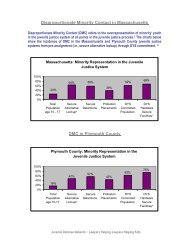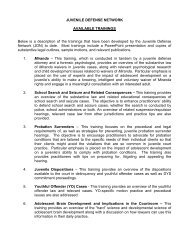Adolescent Brain Development - the Youth Advocacy Division
Adolescent Brain Development - the Youth Advocacy Division
Adolescent Brain Development - the Youth Advocacy Division
You also want an ePaper? Increase the reach of your titles
YUMPU automatically turns print PDFs into web optimized ePapers that Google loves.
III. Academic Articles<br />
Elizabeth Cauffman et. al., Age Differences in Affective Decision Making as Indexed by Performance on<br />
<strong>the</strong> Iowa Gambling Test, DEV. PSYCHOL., 193 (2010).<br />
• Study showing that adolescents perform more poorly than adults in decision-making tasks where<br />
affective processing is involved and respond differently to rewards.<br />
• “[D]ecision making, which frequently precedes engaging in risk-taking behavior, indeed<br />
improves throughout adolescence and into young adulthood … this improvement may be due not<br />
to cognitive maturation but to changes in affective processing. Whereas adolescents may attend<br />
more to <strong>the</strong> potential rewards of a risky decision than to <strong>the</strong> potential costs, adults tend to<br />
consider both, even weighing costs more than rewards.<br />
This higher level of approach behavior during adolescence coupled with <strong>the</strong> lesser inclination<br />
toward harm avoidance may help explain increased novelty-seeking in adolescence, which can<br />
lead to various types of risk taking, including experimentation with drugs, unprotected sex, and<br />
delinquent activity.” (206)<br />
Laurence Steinberg, <strong>Adolescent</strong> <strong>Development</strong> and Juvenile Justice, 16 ANN. REV. OF CLINICAL<br />
PSYCHOL. 47 (2008).<br />
• Excellent overview of adolescent development research. Outlines <strong>the</strong> implications of adolescent<br />
brain, cognitive, and psychosocial development on culpability, competence to stand trial, and<br />
impact of sanctions on adolescents.<br />
Laurence Steinberg, A Social Neuroscience Perspective on <strong>Adolescent</strong> Risk-taking, 28<br />
DEVELOPMENTAL REV. 78 (2008).<br />
• Summarizes brain development research and discusses why risk-taking behavior increases from<br />
childhood to adolescence and decreases from adolescence to adulthood.<br />
• “As a consequence of [neural transformations], relative to prepubertal individuals, adolescents<br />
who have gone through puberty are more inclined to take risks in order to gain rewards, an<br />
inclination that is exacerbated by <strong>the</strong> presence of peers. This increase in reward-seeking … has<br />
its onset around <strong>the</strong> onset of puberty, and likely peaks sometime around age 15, after which it<br />
begins to decline. Behavioral manifestations of <strong>the</strong>se changes are evident in a wide range of<br />
experimental and correlational studies using a diverse array of tasks and self-report instruments<br />
… and are logically linked to well-documented structural and functional changes in <strong>the</strong> brain.”<br />
(92)<br />
Jeffrey Fagan, Juvenile Crime and Criminal Justice: Resolving Border Disputes, 18 FUTURE OF<br />
CHILDREN 81 (2008). http://futureofchildren.org/futureofchildren/publications/docs/18_02_05.pdf (last<br />
visited Apr. 30, 2010)<br />
• “Without exception <strong>the</strong> research evidence shows that policies promoting transfer of adolescents<br />
from juvenile to criminal court fail to deter crime among sanctioned juveniles and may even<br />
worsen public safety risks. The weight of empirical evidence strongly suggests that increasing<br />
<strong>the</strong> scope of transfer has no general deterrent effects on <strong>the</strong> incidence of serious juvenile crime or<br />
specific deterrent effects on <strong>the</strong> re-offending rates of transferred youth. In fact, compared with<br />
youth retained in juvenile court, youth prosecuted as adults had higher rates of rearrest for serious<br />
felony crimes such as robbery and assault. They were also rearrested more quickly and were<br />
more often returned to incarceration.” (105)<br />
Barry Feld, A Slower Form of Death, 22 NOTRE DAME J.L. ETHICS & PUB. POL’Y 9 (2008).<br />
• Argues that <strong>the</strong> diminished responsibility rationale in Roper should be extended by state<br />
legislatures to recognize youthfulness as a categorical mitigating factor in sentencing.

















